Look and Feel
Model Suitability (out of 10):
Attributes (out of 10):
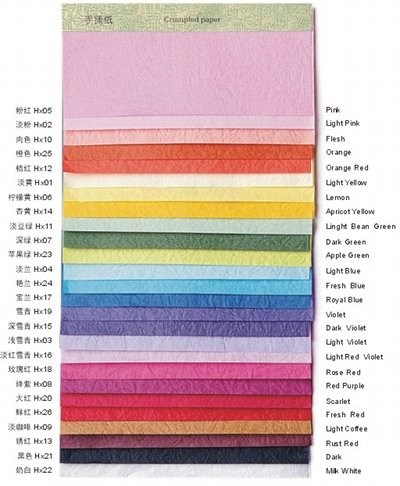
Many years ago there was a shop in Tel Aviv that had a uniquely textured paper. It was called Twist paper. And then it was gone. Many years later, a new paper came to my attention. This paper is commonly known as VOG paper, since it was introduced by the Vietnamese Origami Group. Having now had hands-on experience with VOG I can say for sure - the Twist is back!
This paper is made in China and is sold in Vietnam as a wrapping paper for flowers and gifts. When it was discovered by the VOG, the makers said that "a new use was given to him, making it and its producers proud" (quoting from their forum with the help of Google Translate). Its brand name is really Crumpled Paper and there is another version, Pearl Crumpled Paper.
I have no information on the manufacturing process, but according to the published details, the paper has an "assurance of water resistance and expressive performance" and it's best used for "Floral wrapping, gift boxes, book-binding and other artistic covering applications". It is made by Wenzhou Kingdee Art Paper Co. Ltd., and is one of their 1800 available products.
The company's products are sold in the United States, Europe, Japan, South Korea, Singapore and the Middle East. At least, this is the official statement. I got very little help from the manufacturer, so many details are still a mystery - like: how do they get those bumps?
Properties
- Thickness: The stated weight for both types is 58 gsm. Our lab report says it's lighter than that: 48 gsm for the crumpled and 51 gsm for the Pearl coated version. The minor difference between both can be explained, but not the diversion from the official data. The test was performed twice on each paper with highly accurate equipment. But the actual thickness was difficult to measure. The machine was totally confused with all the bumps. The numbers we got started with 180 micron (Elephant Hide is 135!) and went down with time to 130. It's certainly much thinner than those numbers would indicate.
- Sizes: Only one option, a 64×64 cm square. Perfect for a 64 grid of 1cm!
- Colors: With no official data, I counted 28 colors of Crumpled, and only 12 of the Pearl Crumpled paper. The palette is basic, with strong and dominant colors such as red, dark blue, green and orange. The Pearl Crumpled uses the same colors, but the coating changes the look of the colors. While one side has the same color as the non-coated paper, the coated side is slightly lighter.
- Paper Coloring or Colorability: Applying water color (by Ecoline) gives good results when using the Crumpled paper. As can be seen in the image, the correct color can be achieved if coloring white paper, or dark paper with dark colors. Alas, when I used the light blue watercolor on the harsh yellow paper it resulted in green. The Pearled paper just rejected the color (it is water resistant!).
- Texture: It's called Crumpled, but it is more embossed than crumpled. It's as if you took a flat paper and pressed it on an asphalt road to get many little bumps all over. The two sides of the paper are slightly different. One side seems to be coated with a very thin translucent and reflective material. The Pearl Crumpled coating is thicker, which makes it shine more. The uncoated side (where the hills become depressions) of both types is matt.
- Aging and Wear and Tear: 3 years ago Herman folded an elephant from Twist paper. Now it can hardly stand on its legs. Although the paper hasn't faded, it's far from holding its own weight for long. Compare it to Elephant Hide, folded at the same time. The bumps weaken the paper, so if a tear meets such a bump it will continue until it hits the edge of it. In the Tear Machine it scored 290 and 500 (with and against the grain respectively), much less than printer paper (510/580).
- Memory: High. Make a crease and it will stay. The paper hardly jumps back. 8 out of 10.
- Forgiveness: Fair. When you try to reverse a fold, it's difficult to see the fold line on the other side. Once it's found and the reverse fold started, it becomes visible and can be reversed easily. 6 out of 10.
- Tensile Strength: We refer here to the maximum stress the paper can undergo while being stretched or pulled. The value for this paper is 4 kg, roughly half that of printer paper and a quarter of Elephant Hide. However, since it is half the weight of either, you could say that it has the same tensile strength as printer paper in proportion to its weight. 4 out of 10.
- Bending Resistance: This section rates the amount of force you need to apply to get a sharp crease and how strong the paper is while being curved (like during the puffing of the PowerPuff unit). Curving is not a strong feature. The numbers (16 to 40) are even less than for Japanese Foil (30/52), but to get a sharp crease no high pressure is needed. 4 out of 10.
- Photogenic: Interesting may be the perfect description. The bumps and shiny coating give the final model an appealing look.
- Where to buy: If you live in Vietnam, go to almost any flower shop and ask. If you live elsewhere you are very limited even with online options. I searched many sites to no avail. All the usual places, from Kim's Crane to Amazon don't carry it. The few places that do sell it, sell it by the tonne for distributors only. The only real option is Origami-Shop.com. Nicolas Terry has a limited stock and this is where I bought my own.
Test results
Traditional use
Traditional Crane, 15×15cm
The first impression when holding and feeling this paper is that it won't work. However, the folding experience is very good. Although it doesn't have a smooth surface, it folds just as well as paper that does. Surprisingly enough (a repeated motif in the article) it was easy to get a sharp beak and tail. As I've done previously, I left some space when I narrowed beak and tail, so reverse folding them brought them to the exact place.
Action model
There is no real value in using this paper for action models. They all worked, but not particularly well.
Barking Dog by Gadi Vishne, 15×15cm
The dog barked, but quietly!
Traditional Flapping Bird, 15×15cm
The bird flapped only weakly.
Traditional Jumping Frog, 15×15cm
The frog jumped just a little.
Tessellation
Pineapple tessellation by Ilan Garibi, 46×46cm
I wanted to have relatively big molecules, to show off the pattern. Folding the grid went reasonably well, but with two problems. First, it was very hard to see the crease lines on the pearly side. Since those are your guidelines, it was a headache. The second problem arises from the unevenness of the surface - from time to time your fold line falls on the edge of a small “hill” and it becomes crooked. Reversing the grid was not easy, although not a real problem. Once the grid was ready, the remaining pre-creases were very easy to do. Collapsing the tessellation was surprisingly easy. The paper is thin and doesn't feel like a 'snappy' paper like Stardream or Elephant Hide, but nevertheless all creases bent in the right direction and fell perfectly into space. This was actually the easiest collapse so far. The final result is quite unusual - the flat surface is pearly, shining with a faded yellow, but then the pineapple molecules reflect the light differently and shows a strong and sharp yellow.
Mystery tessellation by Ilan Garibi, 22×22cm
I folded this to get a backlit image. I just love this paper with back lighting! It is spectacular. It looks like thick gravy, or coloured hot lava. Fabulous!
Complex
Pegasus by Satoshi Kamiya, 38×38cm
Although you will rarely see a green pegasus in nature, I highly recommend Crumpled for this model. It was easy to fold with all the way, from first creases - sharp and accurate - to the final little details. Sinking was easy, shaping the legs was a breeze, the head came out perfectly, and the multi-layered tail shaped well. The final result is well-proportioned and can be moulded with no need for wet folding.
Modular/Unit Origami
PowerPuff modular by Ilan Garibi. 30 units, 12×12cm
All the downsides of this paper came out in this model. Even before the first fold, cutting it into squares was a problem. I usually fold it as desired and cut it with an envelope opener, but here the bumps made the gadget unreliable and I had to cut it with a knife. Folding was easy, but puffing was definitely not. The bumps wouldn't let me shape the edges of the rounded part. The surface tension is low and the look is not satisfying. Even worse was the assembly. The paper is too soft for the tabs to be inserted into the pockets. It just crumples before going into place. I had to glue every third unit, since the tab should go into a bent pocket - which is an impossible task with such a soft paper.
3D models
Rat by Eric Joisel, 20×20cm
The texture of the paper screamed to me - animals! So I decided to add two more 2D animal models: a kangaroo and a giraffe by Peter Engel. This thin paper remembers the creases well, but with many layers it tends to open up too easily, maybe because of the spring action the bumps give it. Using some MC can counter that effect and improves the final result dramatically. On the other hand, it does seem that the embossing gives the paper some extra strength.
Fox Terrier by Francisco Javier Caboblanco, 20×20cm
All went well, until the last step, going 3D. Trying it without wet folding showed me why we consider this to be a wet folding test. The model spread its legs wide and nothing could hold them back. I used some moisture on the inside and outside and things improved. The paper's manufacturer says that it is water resistant but it isn't. The paper absorbs water, but does not get mushy, nor does it easily tear. Moreover, all the bumps are gone once it dries.
Wet Folding
Polar Bear by Giang Dinh
The paper is much too thin for wet folding the Polar Bear model.
Final verdict
I love this paper. It got Gadi hooked, too. I was very happy with both the process and the result for tessellations and complex models. Even simple 2D models came out nicely, as you can see with the giraffe and kangaroo, neither usually on our list of models. Using wet folding in the process may become awkward, since water tends to flatten away all the crumples. And the paper is way too thin for wet folding. For modulars it is not recommended.
Searching flickr for VOG only one image that uses this paper was found. All the others were images of the actual VOG people and their models. Even trying Twist, Crumpled and Pearl gave no results. I am not saying nobody is using it, just that no one cares to mention the name.
This isn't surprising, since it is very difficult to find if you do not live in the Far East. With only one online option, and probably the only option including off-line shops, it will be hard to get your hands on it. But it will surely be profitable if you do!
Be aware, the numbers in the summary table do not do justice to strength and beauty of VOG paper. We highly recommend trying it.
Bottom line: old or new, it's hip and refreshing!

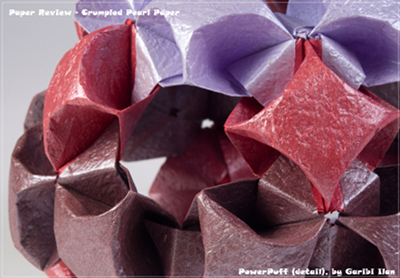
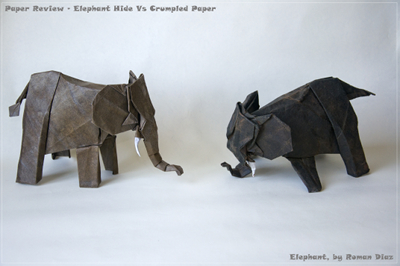
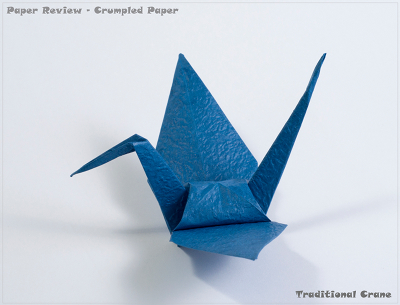
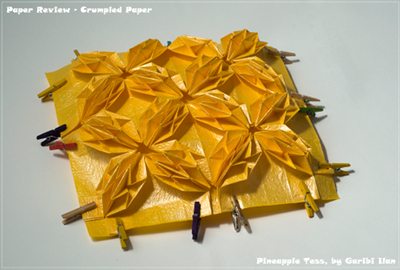
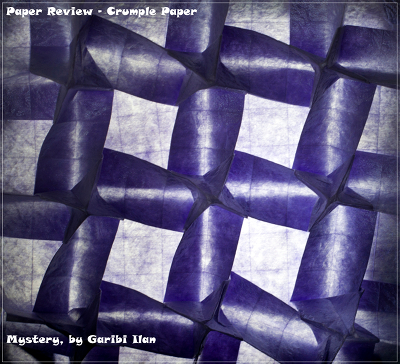
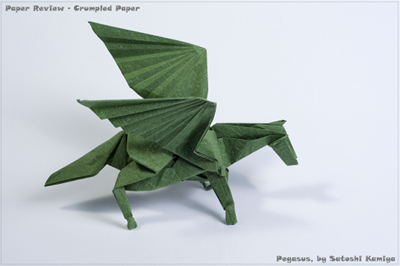
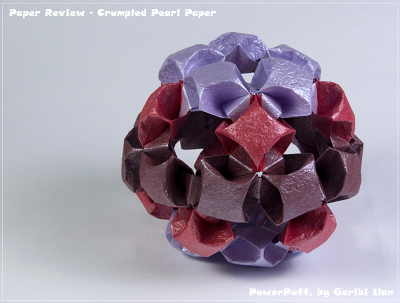
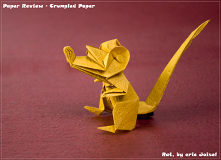
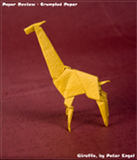
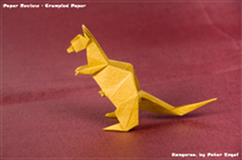
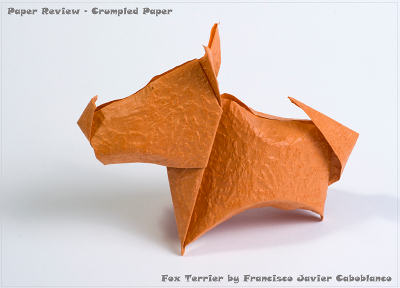
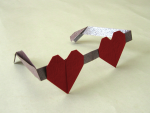
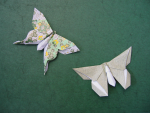
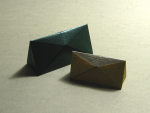
Comments
Submitted by Anonymous (not verified) on 8 December 2011 - 8:31am Permalink
This paper is used many by
This paper is used many by VOG members, because in vietnam is chepear and easy to find. Many years ago i contact manufacturer and you can buy starting from 2000 sheets same color. We need to wait to see this paper on others shops, because in my opinion is one of best paper for origami.
Submitted by Anonymous (not verified) on 11 December 2011 - 1:37pm Permalink
I know this paper
One month ago I bought this paper in Moscow. It was sold as a wrapping paper, 64x64 everything matches! And I should say it's okay for modulars. I didn't fold many, But I'm satisfied. The locks of modulars must be strong enough thogh=)
I don't have pics jet, but I'll have them in 2 weeks I think. And of course I didn't know that it's called VOG paper!
Here are my pics
http://www.flickr.co...
http://www.flickr.co...
ps. if somebody lives in Moscow too, I can say that this paper is sold here:
http://www.giftway.r...
It's called "soft metal" ;-) and costs ~24 roubles or ~0.8$ per sheet